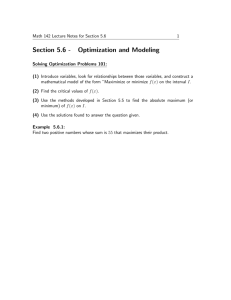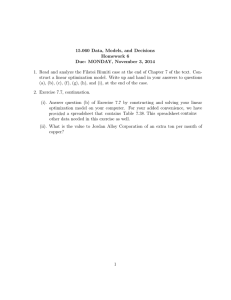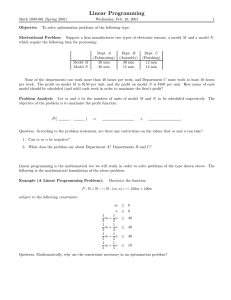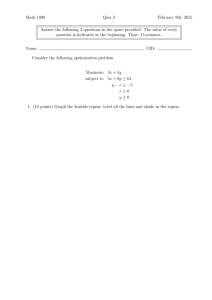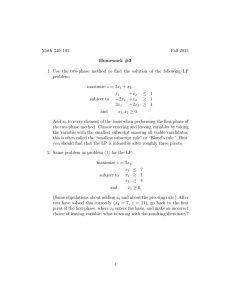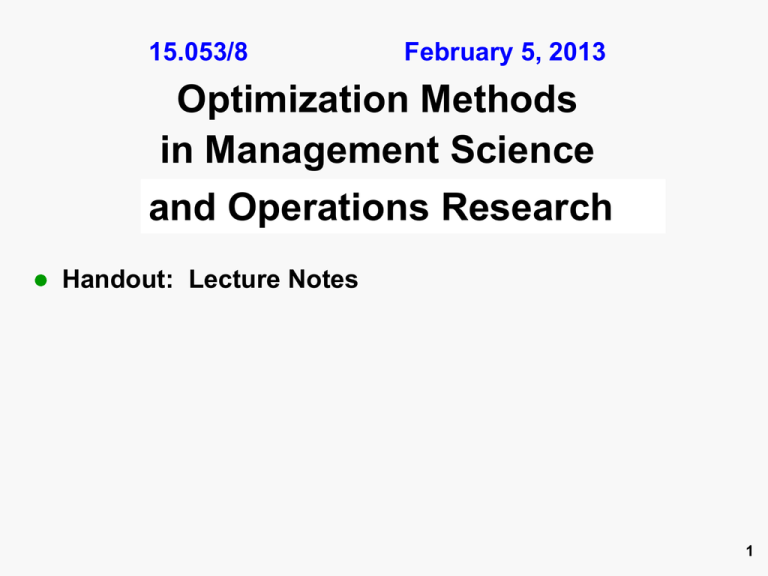
15.053/8
February 5, 2013
Optimization Methods
in Management Science
and Operations Research
Handout: Lecture Notes
1
Class website + more
Class website
– please log on as soon as possible
– Problem Set 1 will be due next Tuesday
Lots of class information on website
Piazza.com used for Q&A and discussions
No laptops permitted in class, except by permission
laptops
2
We will use clickers from Turning Technologies.
If you own one, please bring it to class with you,
starting Thursday.
If you don’t own one, we will lend you one for the
semester.
3
Videotapes of classes
Current plan: start videotaping lectures starting
Today (I think).
In addition, PowerPoint presentations will all be
available.
4
Excel and Excel Solver
During this semester, we will be using Excel
Solver for solving optimization problems.
We assume some familiarity with Excel, but no
familiarity with Excel Solver.
Homework exercises involve Excel.
– Versions A and B (experiment starting this year).
– Excel Solver tutorial this Friday
5
An optimization problem
Given a collection of numbers, partition them into
two groups such that the difference in the sums
is as small as possible.
Example:
7, 10, 13, 17, 20, 22
These numbers sum to 89
I can split them into {7, 10, 13, 17}
{20, 22}
Difference
sum is 47
sum is 42
= 5.
Can we do better?
Excel Example
6
What is Operations Research?
What is Management Science?
World War II : British military leaders asked scientists
and engineers to analyze several military problems
– Deployment of radar
– Management of convoy, bombing, antisubmarine, and
mining operations.
The result was called Operations Research
MIT was one of the birthplaces of OR
– Professor Morse at MIT was a pioneer in the US
– Founded MIT OR Center and helped to found ORSA
7
What is Management Science
(Operations Research)?
Operations Research (O.R.) is the discipline of
applying advanced analytical methods to help
make better decisions.
O.R. is an engineering and scientific approach for
decision making.
8
Some Skills for Operations Researchers
Modeling Skills
– Take a real world
situation, and
model it using
mathematics
Methodological
Toolkit
– Optimization
– Probabilistic
Models
Photo of female
model removed
due to copyright
restrictions.
Not this
Images removed due to copyright restrictions. See images
of domino mosaic art at http://www.dominoartwork.com/.
Adriana Lima
Not this
type of
modeling
9
The Value of Operations Research and
Management Science
Making sense of data
– big data
– social network info, transactional data, polls
Dealing with complexity and uncertainty
– understanding systems
– making a good choice when there are billions of options
(e.g., partitioning with 50 items)
– making good choices in an uncertain world
Using mathematical models to augment our own
thinking.
– develop insights
– develop plans
10
Preview of Some Applications
Applying LP and
NLP to optimal
radiation therapy.
How to set prices.
Photo courtesy of epSos.de on Flickr. License CC BY.
11
Preview Continued
© Google. All rights reserved. This content is excluded from our Creative Commons
license. For more information, see http://ocw.mit.edu/help/faq-fair-use/.
Find the shortest path in a network
12
More preview
Optimal strategies
against adversaries.
Photo courtesy of Curtis Perry on Flickr.
How to solve
some
challenging
puzzles
13
Some of the themes of 15.053/8
Optimization is everywhere
Data, Models, Algorithms, Insights, and Decisions
– DMAID
14
Optimization is Everywhere
Personal choices
–
–
–
–
best career choices,
best use of our time
best strategies,
best value for the dollar
Company choices
–
–
–
–
–
–
maximize value to shareholders
determine optimal mix of products or services
minimize production costs
minimize cost of getting product to customers
maximize value of advertising
hire the best workers
15
Your class partner
Introduce yourself to the person next to you (right or
left), who we refer to as your “partner” for today.
Those on aisle ends may be in a group of size 3.
There will be a team project in which student groups
will solve or attempt to solve an optimization that is
useful in practice. This will involve collecting data,
making a model and doing some analysis.
Take 3 minutes with your partner to brainstorm on
the type of problems you might be interested in
doing a project on.
16
Some initial ideas for projects
What did you come up with?
17
Midclass break
We searched Google for the number of pages
with the expression “optimal X”
There are at more than 10 expressions that have
over 1 million hits. See if you can find them.
18
On 15.053/8 and Optimization Tools
Rest of the class
– Introduce linear programming (LP) (also called linear
optimization)
– illustrates an important optimization tool for better
decision making.
– Efficiently solvable. LPs form the basis for solving
more complex problems.
19
The optimization paradigm
Decision variables: the elements that are under the
control of the decision maker.
– The work schedules of each employee
– The level of investments in a portfolio
– what subjects a student should take in each semester
A single objective function (of the decision variables)
– minimize cost or …
– maximize expected return or …
– make the last semester as enjoyable as possible or …
20
The optimization paradigm
Constraints: restrictions on the decision variables
– “Business rules”
• no worker can work more than 5 consecutive days
• There is at most 2% investment in any stock in the portfolio
• students must take a prerequisite of a subject before taking
the subject
– “Physical laws”
• No worker can work a negative amount of time
• The amount of a goods in inventory at the end of period j is
the amount of goods arriving during period j plus the
amount of goods in inventory in period j-1 minus the
amount of goods that are sold in the period.
21
Generic optimization model
(usually called non-linear programming)
Let x be the vector of decision variables:
Suppose f, g1, g2, … , gm are functions
max f(x)
Maximize the objective
s.t.
gi(x) ≥ bi for each i = 1 to m
Satisfy the constraints
x≥0
typically but not always the case.
22
Linear Programming
minimize or maximize a linear objective
subject to linear equalities and inequalities
Example. Max is in a pie eating contest that lasts 1
hour. Each torte that he eats takes 2 minutes. Each
apple pie that he eats takes 3 minutes. He receives
4 points for each torte and 5 points for each pie.
What should Max eat so as to get the most points?
Step 1. Determine the decision variables
Let x be the number of tortes eaten by Max.
Let y be the number of pies eaten by Max.
23
Max’s linear program
Step 2. Determine the objective function
Step 3. Determine the constraints
Maximize
z = 4x + 5y
subject to
2x + 3y ≤ 60
(objective function)
(constraint)
x ≥ 0 ; y ≥ 0 (non-negativity constraints)
A feasible solution satisfies all of the constraints.
x = 10, y = 10 is feasible; x = 10, y = 15 is infeasible.
An optimal solution is the best feasible solution.
The optimal solution is x = 30, y = 0, z = 120.
24
Terminology
Decision variables: e.g., x and y.
– In general, these are quantities you can control to improve
your objective which should completely describe the set
of decisions to be made.
Constraints: e.g., 2x + 3y ≤ 60 , x ≥ 0 , y ≥ 0
– Limitations on the values of the decision variables.
Objective Function. e.g., 4x + 5y
– Value measure used to rank alternatives
– Seek to maximize or minimize this objective
– examples: maximize NPV, minimize cost
25
Maximize
x1
(A)
subject to
3x1 + 4x2 ≥ 7
x1 - 2x5 = 7
x1 ≥ 0, x2 ≥ 0
(B)
(C)
(D)
(A) is referred to as
(B)
(C)
(D)
1.
2.
3.
4.
Nonnegativity constraints
An equality constraint
The objective function
An inequality constraint
26
David’s Tool Corporation (DTC)
Motto: “We may be no Goliath, but we think big.”
Manufacturer of slingshots kits and stone
shields.
Public domain image (Wikimedia Commons)
Public domain image (painting by
Osmar Schindler, 1888)
27
Data for the DTC Problem
Resources
Slingshot
Kits
Stone
Shields
Stone
Gathering
time
2 hours
3 hours
100 hours
Stone
Smoothing
1 hour
2 hours
60 hours
Delivery
time
1 hour
1 hour
50 hours
Demand
40
30
3 shekels
5 shekels
Profit
28
Formulating the DTC Problem as an LP
Step 1: Determine Decision Variables
K = number of slingshot kits manufactured
S = number of stone shields manufactured
Step 2: Write the Objective Function as a linear function
of the decision variables
Maximize Profit =
Step 3: Write the constraints as linear functions of the
decision variables
subject to
29
The Formulation Continued
Step 3: Determine Constraints
Stone gathering:
Smoothing:
Delivery:
Slingshot demand:
Shield demand:
We will show how to solve this in Lecture 3.
30
Linear Programs
A linear function is a function of the form:
f(x1, x2, . . . , xn) = c1x1 + c2x2 + . . . + cnxn
= ∑i=1 to n cixi
e.g.,
3x1 + 4x2 - 3x4.
A mathematical program is a linear program (LP) if the
objective is a linear function and the constraints are linear
equalities or inequalities.
e.g.,
3x1 + 4x2 - 3x4 ≥ 7
x1 - 2x5 = 7
Typically, an LP has non-negativity constraints.
Strict inequalities are not permitted. (x > 0 is not allowed.)
31
More on Linear Programs
A linear program must have linear objectives and
linear equalities and inequalities to be considered
a linear program.
Maximize
x1
subject to
3x1 + 4x2 ≥ 7
x1 - 2x5 = 7
|x1| ≥ 0
Maximize x2
subject to x = 3
Not a linear
program.
Not a linear
program.
32
A non-linear program is permitted to have a
non-linear objective and constraints.
maximize f(x,y) = xy
subject to
x - y2/2 ≥ 10
3x – 4y ≤ 2
x ≥ 0, y ≥ 0
Minimize x
subject to x ≥ 3
Both a linear and
a non-linear
program.
33
An integer program is a linear program plus
constraints that some or all of the variables
are integer valued.
Maximize
3x1 + 4x2 - 3x3
3x1 + 2x2 - x3 ≤ 17
3x2 - x3 = 14
x1 ≥ 0, x2 ≥ 0, x3 ≥ 0 and
x1 , x2, x3 are all integers
34
Summary
Mathematical models
Optimization as a paradigm
Linear programming
35
MIT OpenCourseWare
http://ocw.mit.edu
15.053 Optimization Methods in Management Science
Spring 2013
For information about citing these materials or our Terms of Use, visit: http://ocw.mit.edu/terms.

